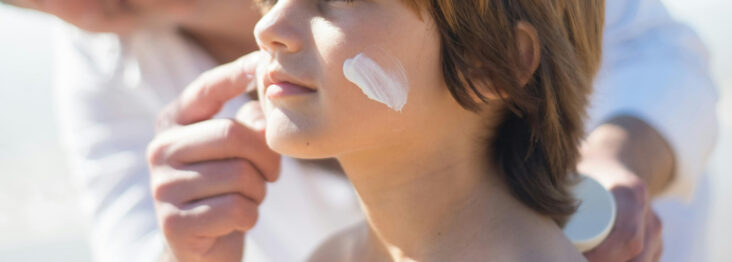Pityriasis Alba

Eleven-year-old Marco came in for his yearly physical and sports exam before starting the 6th grade.
I asked him how his summer had been and what he had done. He had gone to soccer camps and Junior Lifeguards. The lifeguards in many beachside communities run a summer program for adolescents. It is a great opportunity whereby the children spend morning or afternoon at the beach and are taught ocean safety, rescue techniques, physical fitness and good sportsmanship. I could tell that he had been out in the sun by his noticeable tan.
Just then mom said, “Oh, I’m glad you said that because I am concerned about the patches on his face.
I would have forgotten to mention it but I am very concerned.” Sure enough, he had an oval patch on his cheek near the ear. It was about the size of a quarter and there was a smaller dime-size one near his chin. The patches were flat, minimally scaly and whitish in color. The dark tan of his face made them stand out. Mom said she first noticed these patches a few weeks ago and thought they might be ringworm. She treated them with Lotrimin, an antifungal for ringworm, twice a day for two weeks. It didn’t make any difference. Researching the Internet she was afraid that they might be vitiligo. Marco said they did not bother him nor did they itch and had not spread. I looked at the lesions closely and told mom that the patches were nothing to be worried about. They were pityriasis alba, a common skin disorder in children. Anticipating her questioning look, I got a dermatology book to show her pictures of pityriasis alba. She agreed it was identical to the pictures in the book and let out a sigh of relief.
Pityriasis alba is a common skin condition that occurs in around 5% of all children equally in boys and girls.
Typically it appears between the ages of 3 and 16 years. No exact cause is known but some feel it may be a form of atopic dermatitis or eczema. However, it is also known to occur in children with no history of atopy.
It has been described as a non-specific dermatitis with residual post-inflammatory hypo-pigmentation.
It is NOT infectious and NOT contagious. Most lesions appear on the face, typically on the cheeks or chin, but less frequently on the shoulders or upper arms. The patches vary in size from half-an-inch to three-inches. Initially they may be pinkish or red and are oval or round. There may be a little scaling or flaking. After a while, they lose the pinkish color leaving a hypo-pigmented pale area which rarely itches and causes no other symptoms than the pale patch. This could be a solitary patch or multiple patches. There is no seasonal prevalence for it to occur. But it is mostly identified during the summer when children are out in the sun and tanning. The differential between the tan and the hypo pigmented patches makes them more obvious.
Pityriasis alba is a self-limiting condition.
It will ultimately go away within a few months or a year or two without any specific treatment. It is reasonable to use an emollient or a skin moisturizer which will keep the skin moist. This may help speed up the resolution of the patches. If there is itching, a mild topical steroid may be of a benefit.
Other treatment modalities are often mentioned but rarely are they necessary.
These include Tacrolimus which is a topical calcineurin inhibitor used in hard-to-treat eczema. It is very costly. Or there is Calcitrol which is a topical Vitamin D analog or Psoralen plus ultraviolet light. Again, these are not commonly needed or used and would most appropriately be prescribed by a dermatologist.
